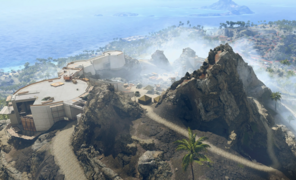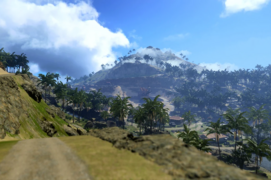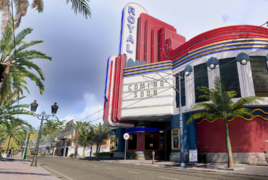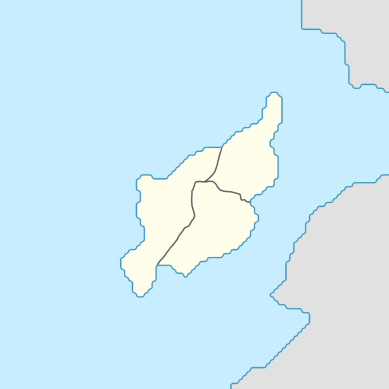Calderan Republic
Calderan Republic | |
|---|---|
Motto: "Si tu put pa, tu es pa qalderano" "If you can not, you are not Calderan" | |
Anthem: "Our Island Nuyak" | |
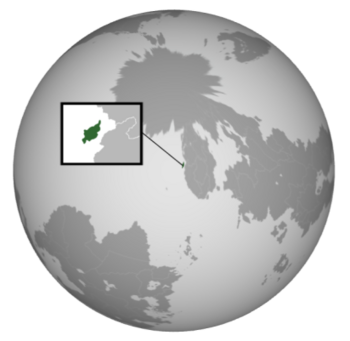 | |
| Capital | Little Caldera |
| Largest city | Neu Maessen |
| Official languages | Volin Kench |
| Recognised national languages | Gothic Burgoignesc |
| Recognised regional languages | Ænglish Sheboan |
| Ethnic groups | 78.4% Volin 15.2% Gothic 6.4% Other |
| Religion | Volinism Christianity |
| Demonym(s) | Calderan (noun/adjective) Calderans (plural) |
| Government | Multi-Party Republic |
| Ben Goodstein | |
| Legislature | National House |
| Establishment | |
• Joseph Seuber organizes Caldera | 1585 |
• Volkspartei Establishment | 16 February, 1600 |
• End of Volkspartei rule | 18 June, 2034 |
• Establishment of the Calderan Republic | 1 January, 2035 |
| Area | |
• Total | 250 km2 (97 sq mi) (42nd) |
| Population | |
• Estimate | 10 million |
• Census | 10,019,538 |
| GDP (PPP) | 2038 estimate |
• Total | $35.277 billion |
| GDP (nominal) | estimate |
• Total | $52,000,000 |
• Per capita | $5,210 |
| Gini (2038) | high |
| HDI (2038) | medium |
| Currency | Calderan Piece (CLP) |
| Time zone | West Cronan Ocean Time (01:00) |
| Driving side | right |
Caldera (Volin: Nuyak), officially the Calderan Republic (Kench: Republiqa Qaldera), also sometimes known as Legastra (see #Legastra), is a country in Cusinaut, Crona. As an island nation, it borders no countries but shares maritime borders with Canespa and Daxia. Caldera is the smallest independent country in the world, and has a tropical climate, which is uncharacteristic for Crona, especially Cusinaut, due to the proximity to the North Pole.
Caldera was infamous for having ruling class of Gothics while the majority of the population were Indigeno-Calderan and spoke Volin, but this changed in 2034, when the first ever multi-party election for Prime Leader was held.
Caldera was not a member of the League of Nations from its creation in 1955 until 2034, when increasing international relations with Canespa resulted in the incredibly isolationist country joining the League of Nations.
Etymology
Caldera was named by the first Ænglish explorers who came to the region. It was clearly named after its most defining feature: a caldera.
In the Volin language, Caldera is referred to as Nuyak, which means "beautiful land".
Prior to the 2034 national election, Caldera's official name was Austro-Caldera, the first half, Austro, referring to being below the North Pole and somewhat south of Canespa. Unsatisfied with the name, Prime Leader LeMieux changed the government's official name to "République Caldaise" after being elected. In early 2037, with the adoption of the Kench language, the name was officially changed yet again to Republiqa Qaldera.
Legastra
Legastra is an exonym for Caldera, first applied to the state by Urcea after the deep dissemination of old Kiravian documents in which most of Crona was described as legally being part of Paulastra, as charter agreements only outlined The Cape and Tierrador as legally independent entities, with the majority of the continent being entitled to the Imperial Kingdom of Paulastra. The word Legastra is itself a portmanteau of the Ænglish word "leg" and the word "astra", which is derived from the latter half of Paulastra's name, being itself taken from Paul Aster, the Levantine explorer who charted Crona in 1387. Leg is applied to Caldera, as Cusinaut, and therefore Caldera, is the "leg" of Paulastra's empire.
The name became popular internationally due to a combination of factors. In Levantia, it was seen as a better name for the state, as Caldera is is confusing with the geographic feature of a caldera. In Kiravia, it was popularized by nationalists who believed the term denounced the Fascist Calderan government and made way for the belief that much of Crona should be part of Paulastra. The term Legastra has also seen usage in Audonia (particularly in Daxia) and southern Crona (in Paulastra). In Caldera, the term Legastra was once used by Volin nationalists in the early 1900s, as it was falsely believed that the name was derived from Latin, meaning "law of the star", implying that the nation should follow Volinism.
History
Pre-history of Caldera
Prior to human settlement in the first century, the Calderan island was believed by nearby civilizations to be the crater where the sun sets, and this created a negative social construct created by mainland Cronan tribes who then restricted settlement of the island for belief that those who settled there would certainly die. Eventually, Caldera was settled by a tribe fleeing their war torn homeland, and the tribe was unaware of the myth that Caldera was dangerous.
This tribe would eventually become what is referred to in the modern day as Volins, or Indigeno-Calderans, the first humans settling on the island.
Early Indigeno-Calderans
In the first century, Caldera was migrated to by natives from mainland Cusinaut. They developed differently than elsewhere in Crona, building their society around fishing. Because of this, they developed a religion coined as "Volinism", based around their God of the Sea (Mashk) being the most supreme being. This culture was the culture that Paul Aster encountered in his 1387 expedition. These indigenous Calderans also wore different clothes and adopted a much different language than what's seen elsewhere in Crona. This difference has been attributed to the death, or cultural assimilation of tribe members who didn't make it to the island.
Native Calderans formed a primitive form of government in which the party leader was chosen via trials meant to appease to a certain god. Anybody who could pass the trials would be given the title of "chosen child" of the god you appeased. There was only one chosen child at a time, anybody who performed a successful trial would immediately become a leader.
Yonderian Immigration (1555-1585)
Levantine explorers during the 1500s charted Crona, and made journals chronicling the most defend-able locations around the continent. When the Great Confessional War broke out in 1555, this was especially important to Yonderian Gothics seeking a new land to settle as their own nation without a Burgoignesc upper class. The Gothic immigrants wanted a land that was easily able to be protected against the Grand Duke of Yonderre if he was to pursue his fleeing subjects, so they chose the island Caldera. Immigration especially increased during the first potato war, with refugees taking large boats holding hundreds heading to the island.
After seeing a massive influx of migrants in 1585, Joeseph Seuber realized that the natives could easily overturn the Goths unless they establish a ruling class. Displaying advanced Levantine technology, it was easy for Seuber to convince the indigenous population of Caldera to accept him as leader.
Early Government (1585-1600)
The first Calderan government was an absolute monarchy under Joeseph Seuber's organization, but this was contested by various Gothic immigrants who disliked the monarchy of Yonderre and wanted to elect the leader in the new country. Seuber came up with a plan to draft a constitution that allows himself to rule as the only member of the Volkspartei, but people would "vote" for him, so he'd be the elected leader out of the best running candidates.
Post-Seuber Rule (1600-1936)
After Joeseph Seuber's death, Calderans continued his tradition of admitting the best fit leaders into the Volkspartei, and holding elections every 15 years for a new leader.
The Volkspartei generally avoided managing the whims of people's daily lives, especially in Bavogia. This generally helped create a positive view of the Volkspartei by the Indigeno-Calderan population as they saw the government as not important.
Military Oriented Rule (1936-2034)
During the First Great War, Caldera managed to narrowly evade involvement, while contributing manufactured weapons to Yonderian allies. However, during the Second Great War, Daxian forces invaded Crona, forcing Caldera to begin pouring funding into military and launch defensive engagements. This began the tradition of native conscription, causing mild controversies within the Vokspartei, but eventually it was decided that Volins exist to be the guard of the Volkspartei.
After the SGW, the country became much more militaristic with higher funding to military, and the Volkspartei began to slowly encroach upon people's lives in ways that were not seen positively, and slowly people began to detest the party.
Post-Volkspartei Rule (2034-Present)
Due to foreign pressure from Canespa and the threat of Bavogia's annexation, the first amendment ever made to the Calderan constitution took place. This amendment enabled any political party to be elected for Prime Leader, and all parties would be then treated equal. This new era of multi-party Republican control has ushered in a wave of new changes surrounding the country's inclination towards Gothics.
Geography
As an island, Caldera has an unusual tropical climate which contrasts with harsh winters elsewhere in Crona. Caldera also has a mountainous center surrounded by its caldera, with the Krein river flowing through much of the island. These unique conditions have led to the development of unique Calderan wildlife.
Government and Politics
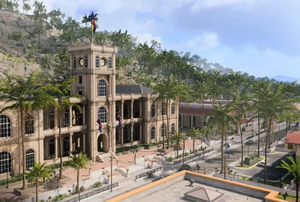
President
The Calderan Republic is headed by one leader, the President, who asserts control over the entire country, similar to the Prime Leader of the past. The President must be elected in a direct democratic election every 4 years. There is no term limit, Presidents may run for re-election as many times as they want.
National House
Located in Little Caldera, the National House is the name of Caldera's legislature. The National House is operated by 30 representatives, 10 from each province, who then serve 5 year term limits.
Subdivisions
Caldera is separated into 3 provinces, the western province is mostly industrial with factories, the northeastern province is residential and governs over the majority of Volins, and the southeastern province is a combination of commercial and residential while being governed by a majority Gothic population.
| Map of the Provinces of Caldera |
|---|
Politics
The Volkspartei, or People's Party, ruled over Caldera from 1600 until 2034. While there are many political parties, such as the Ænglish Minority Party, the Deer Party, the Division Party, the Sirkup Party, the Bavogian Freedom Party, the Bavogian Kingdom Party, and a plethora of others, there are only 3 major political parties alongside the Volkspartei that tend to reach national representation. The Calderan Unity Party is the most popular conservative choice, and the Calderan Restoration Party is the most popular liberal choice. The fourth political party that sees popularity is the Yellow Party, which aims to promote a similar liberal government as the CUP but without as much social equality and while maintaining a conservative budget.
| Party Name | National House | Presidency | Platform | |
|---|---|---|---|---|
| Volkspartei | 14 / 101 |
0 / 1 |
Gothic Nationalism, Conservatism | |
| Yellow Party | 37 / 101 |
0 / 1 |
Economic conservatism, social liberalism | |
| Calderan Unity Party | 16 / 101 |
1 / 1 |
Populism | |
| Calderan Restoration Party | 16 / 101 |
0 / 1 |
Liberalism |
Law
Law is enforced by the Bureau of Criminal Apprehension, and the BCA is also responsible for ensuring no human rights are violated by the government, as established in the 1600 Constitution.
Demographics
Ethnicity
Self-reported ethnic origin in Caldera (2034)
The grand majority of Calderans are Volin while other minor ethnic groups include Gothic and Ænglish.
Language
The primary official language used by the government is Gothic, as this is the language that was brought to Caldera by Yonderian immigrants. However, the majority of the population speaks Volin, which is a language that developed in Caldera after the separation of native Calderans from the rest of Crona in the first century. The third official language, which is by far the least spoken, is Ænglish, which became an official language after protesting by the Ænglish Minority Party.
Religion
Religious affiliations in Caldera (2034)
Most Calderans practice Volinism, a religion that's native to the island. Under the Calderan constitution, no laws can be passed to restrict or show favor to a religion, however, many Gothics, and subsequently Volkspartei members, are Christian.
Education
95% of Volins have finished standard education, while only 2% go on to complete secondary education. This is a stark contrast to Gothics, 100% of whom complete standard education, and 85% complete secondary education.
Culture and Society
Education
All education is completely free in Caldera, and it is mandatory to attend 10 years of standard education, which includes 4 years of Gothic classes, 2 years of Yonderian history classes, 1 year of Calderan history, 4 years of science, 4 years of math, and other prerequisites. Secondary education varies in provinces, but the most popular courses include politics in the Southeast, and machining in the west. In Volin dominated cities, secondary education is not encouraged, and most jobs don't require it, while in Gothic cities, secondary education is heavily emphasized, and almost all high paying jobs require at least some form of it.
Attitudes and worldview
Calderans are generally nationalistic and isolationist, trying to avoid other countries as much as possible, with the exception of Yonderre. Despite this, education on foreign cultures is heavily taught throughout school, and many Calderans show an interest in the outside world.
Kinship and family
As with the 1600 constitution, it is illegal for the government to restrict relationships. As such, families tend to be somewhat diverse, falling outside the traditional nuclear family. Gothic Calderans try to maintain that you need to be married to the opposite gender and raise children together, but many Volins simply don't see the purpose of marriage, and as such, very few Volins get married, over 20% hold more than one partner at a time.
Cuisine
As Caldera developed to heavily integrate Gothic culture, the national dish of Caldera is the bratwurst, but much more common traditional dishes often include fish and rice.
Religion
The government of Caldera cannot restrict or show favor to religions, and so, many Calderans are simply indifferent to religion. Gothics maintain Christianity but fail to spread it, while Volins freely practice their native religion of Volinism, or they might not practice a religion at all.
Arts and Literature
As with most things Calderan, Calderan art is seperated into two parts: Volin, and Gothic. Volin artists prior to 1600 often carved out of wood, creating sculptures or simple drawings of famous gods or events. When Yonderian migrants came to Caldera, they introduced music and paintings, sparking an era of Volin artistic expression, usually based around fishing or religion. Gothic art in Caldera is characterized by thematic messages, usually based around "listen to your elders" or nationalistic messages.
The old Calderan national anthem, Neu Haus in Ceuldeland, was written by a Gothic Calderan, and has a message of how great Caldera is to live in, and the new Calderan national anthem, Haus in Neu Berlin, is about failing to listen to your leaders and the problems that it could cause.
Even Gothic movies in Caldera have these thematic messages, with Meine Kraft (2003) telling the tale of how a Calderan would be able to overcome hardships and build up his nation.
Sports
Caldera's most popular sport is kravget, a sport invented by the Volin people in the 10th century. In kravget, there are two teams. The two teams take turns throwing 4 small dics (traditionally slices of wood from a palm tree) at opponents on the other team. If one team manages to hit an opponent without the opponent capturing the disc, then the throwing team scores a point. If the throwing team throws a disc at an opponent and the opponent catches it, then the catching team scores a point. This continues until one team has scored 23 points.
Hockey and soccer are also popular in Caldera, with citizens playing in competitions across Crona.
Symbols
Caldera's most prominent symbol is it's national seal, which features a red triangle in a sea with a sun behind it and three stars above the suns. The triangle represents Caldera island, while the three stars represent the three Calderan provinces. Another common symbol of Caldera is the Calderan finch, a type of finch that's native to Caldera.
Economy and Infrastructure
Industries and Sectors
The largest parts of the economy are ship building and fishing. About 40% of jobs in Caldera are related to fishing or fish hatcheries, while 20% of jobs are related to ship building. In Caldera's provinces, the western province accounts for all ship building in the nation, while the northeast and southeast provinces economies are dominated by fishing. Further in the country, mining is a large industry as well.
Currency
The official currency of Caldera is the Calderan Piece, which were first printed in 1609. Prior to its adoption, Caldera used Yonderre's currency. The obvious reason for replacement is that Yonderre didn't want Caldera to produce its money, but the second reason is that the Volin people refused to accept the currency because they associated the color indigo (which is featured on the 1, 10, and 100 bills) with a sea monster, and they refused to use any collection of money that had the color indigo on it.
One Calderan Piece is equal to 1/2 Cronan Liré.
Healthcare
Healthcare is free for everyone living in the west and northeast provinces, but healthcare in the southeast is only free to members of the Volkspartei. Healthcare is afforded through taxes, which are paid every time a Calderan buys something from a store. Furthermore, it's possible to purchase a premium pass, by paying extra money monthly to certain hospitals, Calderans are able to skip standard waiting lines and have access to faster treatment. Members of the Volkspartei receive this treatment for free in all designated government hospitals.
Labor
Caldera has extensive labor laws that are enforced by the Calderan Bureau of Criminal Apprehension. Employers are not allowed to overwork employees, force them to work on a day off, force them to work more than 6 hours in a day, and every employee has a minimum of 5 expendable vacation days every month, which is refreshed at the beginning of a new month.
The Free Labor Party is a political party with the goal of raising the minimum wage from 25 pieces to 50 pieces, and lowering the work hours to 4 hours a day, as well as making it illegal to work on weekends, but the Free Labor Party has had less legislative wins than the Work Harder Party, who encourage the government to raise the maximum working hours to 12 in a day.
Transportation
Transportation in Caldera is defined by the car. In the early ages of the country's existence, Volins simply did not travel far accross the island, due to the harsh brush and environments that separated people. This changed when the Yonderian migrants came to Caldera and built infrastructure like roads for horses, now Volins were able to traverse anywhere on the island they wanted. The invention of the car only amplified the ease of access across the island, and it's now the number 1 way that Calderans commute to work.
In the southeastern province, trams are also a popular way to travel, with tramlines running through cities and even up the caldera itself.
Technology
Caldera is not a very technologically advanced country, as most of the country uses technology from the 1950s, Volkspartei cities are a lot more advanced with specific research centers going to meet all the needs of the party.
Military
Caldera was once a very peaceful nation, one of the few countries in the world without a formal military from 1585 until 1934. Caldera was forced to adopt a military during the Second Great War, and has since maintained a very large and powerful military with many cultural aspects being focused around Caldera's military.
Caldera's military is all organized under one entity, the Calderan Armed Forces. This military is quite proportionately large, thanks to mandatory conscription for all Volins. Despite the massive size, the military is underfunded, resulting in soldiers using armor from 1944 with the newest weapon being the C19 rifle, released in 2019 and still not fully replacing all SG56 rifles in service.

